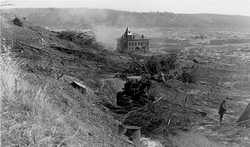Enfield, Massachusetts
| Enfield, Massachusetts | ||
|---|---|---|
| Town | ||

"The end of Enfield." A photograph of downtown Enfield, after 1938.
|
||
|
||
| Coordinates: 42°19′0″N 72°19′58″W / 42.31667°N 72.33278°WCoordinates: 42°19′0″N 72°19′58″W / 42.31667°N 72.33278°W | ||
| Country | United States | |
| State | Massachusetts | |
| County | Hampshire | |
| Incorporated | February 15, 1816 | |
| Disincorporated | April 28, 1938 | |
| Time zone | Eastern (UTC-5) | |
| • Summer (DST) | Eastern (UTC) | |
| GNIS feature ID | 617477 | |
Enfield was a town in Hampshire County, Massachusetts. The town was lost as a result of the creation of the Quabbin Reservoir.
Incorporated in 1816 from portions of Greenwich and Belchertown. It was named in honor of one of its early settlers, Robert Field. General Joseph Hooker, Union general during the American Civil War, was once a resident, and his grandfather was once a town leader. It was centered at the junction of the east and west branches of the Swift River, and the Athol Branch of the Boston and Albany Railroad ran through the town. The town bordered six other towns - Belchertown, Pelham, Greenwich, Prescott, Ware, and Hardwick.
Enfield was disincorporated on April 28, 1938 and portions of the town were annexed to the adjacent towns of Belchertown, New Salem, Pelham, and Ware. (Not all of the former town is now in Hampshire County: the portion ceded to New Salem is now in Franklin County.) The headquarters of the Metropolitan District Commission during the construction of the Quabbin Reservoir was located in the former town hall, and was the last building razed in the Swift River Valley, in 1940. The majority of the town center now lies submerged beneath the reservoir, although the Quabbin Observatory and Enfield Lookout, located on scenic Quabbin Hill, as well as the main entrance and headquarters of Quabbin State Park, a popular tourist destination with an emphasis on state history and nature, are all within the former town's limits.
...
Wikipedia

